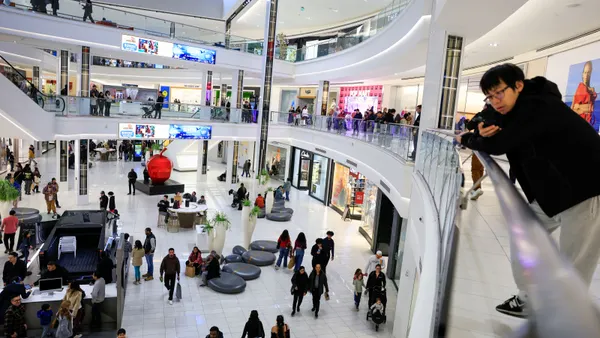Dive Brief:
-
H&M on Thursday said that “continued expansion and tight cost control” led to a 10% second quarter profit rise (after financial items) to 7.71 billion krona ($904 million). Sales in the U.K., Scandinavia, Eastern Europe and in many growth markets “were good,” CEO Karl-Johan Persson said in a statement, but the brand struggled more in several major markets including the U.S., China, the Netherlands and Switzerland.
-
Markdowns in relation to sales rose by 0.7 percentage points in the quarter compared to the year-ago quarter, and high inventories and lower-than-anticipated sales growth led to increased markdowns, the company also said. E-commerce in some markets now accounts for 25% to 30% of total sales, and profitability of digital sales is in line with that of the physical stores.”
-
The fast-fashion retailer also said that it will open an Arket store in hometown Stockholm in spring 2018, following openings in London, Brussels, Copenhagen and Munich and the launch of the e-commerce site this fall. Arket will offer a “broad yet selected range” of apparel for men, women and children, as well as a smaller, curated assortment for the home, priced slightly higher than H&M. Some Arket stores will include cafes.
Dive Insight:
Not long ago H&M insisted that its store-focused approach was working, but the fast-fashion retailer now appears to be rising to the e-commerce challenge. This was underscored by the company’s litany of new e-commerce sites: the flagship H&M brand has or will establish eight new online stores globally this year, with a site planned for India next year, and is now available in 41 markets; the new Arket banner will launch with 18 online markets this year. The company said it expects online sales to grow by at least 25% each year going forward.
That will depend on improvement, diversification and expansion of the company’s online offering, involving more and faster delivery options, more payment alternatives, a broader range of products and more new markets. As it has in recent quarters, the company emphasized efforts to increase the speed, efficiency and flexibility of its supply chain and turn to advanced analytics to help improve its product range development, quantification, allocation and personalized communication.
Also as part of its e-commerce growth, the company is working to integrate its many physical stores with online operations – “to offer a shopping experience where customers are always able to move freely between our various channels and shop in the way that suits them best,” the company said.
Still, stores remain key and indeed the company sees them as helpful to its e-commerce operations, saying, “our global store network gives us a unique proximity to our customers, which is a great asset and advantage.” But its brick-and-mortar expansion — some 500 new stores are set to open this year — will be centered on growth markets, and some 100 will close. New and remodeled H&M stores will include “new forms of visual expression for a more inspiring in-store experience,” the company said.
Along with its brick-and-mortar footprint, the launch of new global brands is essential in the retailer’s growth strategy, the company said, noting that the value of the COS brand, which will reach revenues of around 10 billion krona ($1.19 billion) this year with profitability in line with that of the H&M brand, “already far exceeds the amount we invested in it.”














